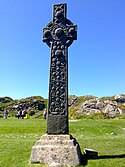
A cross is a geometrical figure consisting of two intersecting lines or bars, usually perpendicular to each other. The lines usually run vertically and horizontally. A cross of oblique lines, in the shape of the Latin letter X, is termed a saltire in heraldic terminology.

Santiago de Compostela, simply Santiago, or Compostela, is the capital of the autonomous community of Galicia, in northwestern Spain. The city has its origin in the shrine of Saint James the Great, now the Cathedral of Santiago de Compostela, as the destination of the Way of St. James, a leading Catholic pilgrimage route since the 9th century. In 1985, the city's Old Town was designated a UNESCO World Heritage Site.

Celtic knots are a variety of knots and stylized graphical representations of knots used for decoration, used extensively in the Celtic style of Insular art. These knots are most known for their adaptation for use in the ornamentation of Christian monuments and manuscripts, such as the 8th-century St. Teilo Gospels, the Book of Kells and the Lindisfarne Gospels. Most are endless knots, and many are varieties of basket weave knots.
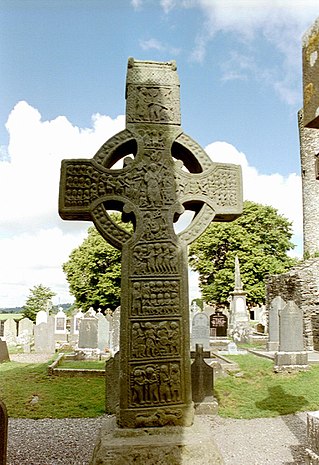
A high cross or standing cross is a free-standing Christian cross made of stone and often richly decorated. There was a unique Early Medieval tradition in Ireland and Britain of raising large sculpted stone crosses, usually outdoors. These probably developed from earlier traditions using wood, perhaps with metalwork attachments, and earlier pagan Celtic memorial stones; the Pictish stones of Scotland may also have influenced the form. The earliest surviving examples seem to come from the territory of the Anglo-Saxon kingdom of Northumbria, which had been converted to Christianity by Irish missionaries; it remains unclear whether the form first developed in Ireland or Britain.

James the Great was one of the Twelve Apostles of Jesus. According to the New Testament, he was the second of the apostles to die, and the first to be martyred. Saint James is the patron saint of Spain and, according to tradition, his remains are held in Santiago de Compostela in Galicia.
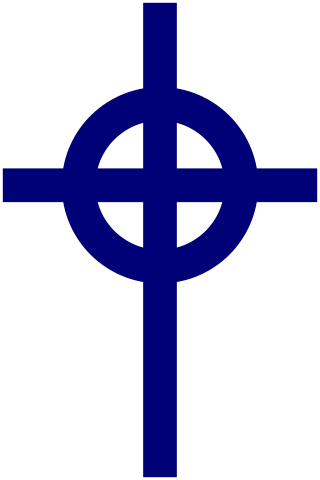
The Celtic cross is a form of Christian cross featuring a nimbus or ring that emerged in Ireland, France and Great Britain in the Early Middle Ages. A type of ringed cross, it became widespread through its use in the stone high crosses erected across the islands, especially in regions evangelized by Irish missionaries, from the ninth through the 12th centuries.

The Chi Rho is one of the earliest forms of the Christogram, formed by superimposing the first two (capital) letters—chi and rho (ΧΡ)—of the Greek word ΧΡΙΣΤΟΣ (Christos) in such a way that the vertical stroke of the rho intersects the center of the chi.
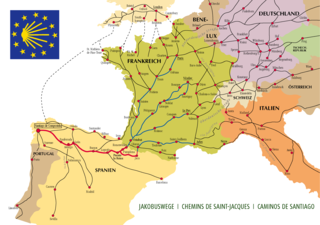
The Camino de Santiago, or in English the Way of St. James, is a network of pilgrims' ways or pilgrimages leading to the shrine of the apostle James in the cathedral of Santiago de Compostela in Galicia in northwestern Spain, where tradition holds that the remains of the apostle are buried.

A sun cross, solar cross, or wheel cross is a solar symbol consisting of an equilateral cross inside a circle.
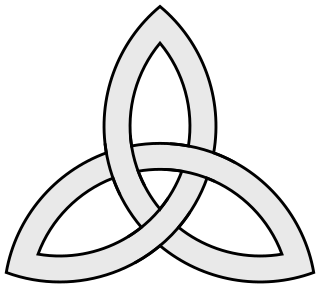
The triquetra is a triangular figure composed of three interlaced arcs, or (equivalently) three overlapping vesicae piscis lens shapes. It is used as an ornamental design in architecture, and in medieval manuscript illumination. Its depiction as interlaced is common in Insular ornaments from about the 7th century. In this interpretation, the triquetra represents the topologically simplest possible knot.

The Jerusalem cross is a heraldic cross and Christian cross variant consisting of a large cross potent surrounded by four smaller Greek crosses, one in each quadrant. It was used as the emblem and coat of arms of the Kingdom of Jerusalem from the 1280s.

A halo (from Ancient Greek ἅλως 'threshing floor, disk'; also called a nimbus, aureole, glory, or gloriole is a crown of light rays, circle or disk of light that surrounds a person in works of art. The halo occurs in the iconography of many religions to indicate holy or sacred figures, and has at various periods also been used in images of rulers and heroes. In the religious art of Ancient Greece, Ancient Rome, Christianity, Hinduism, and Buddhism, sacred persons may be depicted with a halo in the form of a circular glow, or flames in Asian art, around the head or around the whole body—this last form is often called a mandorla. Halos may be shown as almost any colour or combination of colours, but are most often depicted as golden, yellow or white or as red.

The Cross of Saint James, also known as the Santiago cross, cruz espada, or Saint James' Cross, is a cruciform (cross-shaped) heraldic badge. The cross, shaped as a cross fitchy, combines with either a cross fleury or a cross moline. Its most common version is a red cross resembling a sword, with the hilt and the arm in the shape of a fleur-de-lis.
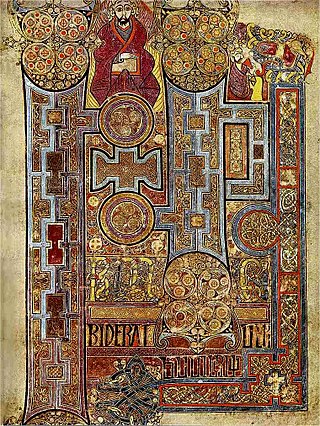
Insular art, also known as Hiberno-Saxon art, was produced in the post-Roman era of Great Britain and Ireland. The term derives from insula, the Latin term for "island"; in this period Britain and Ireland shared a largely common style different from that of the rest of Europe. Art historians usually group Insular art as part of the Migration Period art movement as well as Early Medieval Western art, and it is the combination of these two traditions that gives the style its special character.

Christian symbolism is the use of symbols, including archetypes, acts, artwork or events, by Christianity. It invests objects or actions with an inner meaning expressing Christian ideas.

The Coptic cross is any of a number of Christian cross variants associated in some way with Coptic Christians.

Ethiopian crosses, Abyssinian crosses, or Ethiopian-Eritrean crosses are a grouping of Christian cross variants that are symbols of Christianity in Ethiopia, Eritrea, and among Ethiopians and Eritreans. Their elaborate, stylized design is markedly distinct from other Christian cross variants. Ethiopian crosses are almost always made from elaborate latticework, the intertwined lattice represents everlasting life. No two crosses are exactly identical in style, the artisans who make them being allowed the freedom to exercise a measure of individual taste and creativity in their choice of shape and pattern. Crosses may be of the processional type with a socket at the base so they may be mounted on a staff and carried in church ceremonies or hand-held blessing crosses used by priests in benedictions.

The Monifieth Sculptured Stones are a series of five class II and III standing Pictish stones from the early Medieval period found in or around St Regulus' church in Monifieth, Angus, Scotland. Uncovered during the demolition of a pre-Reformation church and its kirkyard wall in the 19th and 20th centuries, the stones are now housed in the collection of the Museum of Scotland.

The staurogram (⳨), also monogrammatic cross or tau-rho, is a ligature composed of a superposition of the Greek letters tau (Τ) and rho (Ρ).

The Mogao Christian painting, also known as Painting of a Christian figure or Fragment of a Christian figure, is a fragmentary silk painting of a haloed man with crosses on his head and chest who has been interpreted as a Christian figure associated with the Church of the East. The painting dates to the end of the 9th century, during the Guiyi rule of Dunhuang under the Zhang family. It was discovered by the Hungarian-born British archaeologist Aurel Stein at the Library Cave of the Mogao Caves in 1908, and is now kept in the British Museum, London.







